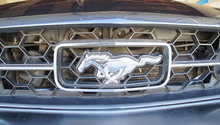Ford Mustang V6 and Mustang GT: How to Check Tire Pressure
Improve the health of your tires by adding only the appropriate amount of pressure.
This article applies to the Ford Mustang V6 and Mustang GT (1994-2014).
Knowing how much pressure you have in your tires is important for a number of reasons. First of all, having too much or too little pressure in your tires could lead to a blowout as well as a marked decrease in fuel economy. As your fuel economy dips, you'll find yourself making more frequent stops to the gas station, which, over time, could spell disaster for your wallet. By staying on top of how much pressure you have in your tires, however, you can minimize your risk for a blowout as well as decrease the frequency with which you fill up the tank in your Ford Mustang.

Material Needed
- Tire pressure gauge
Step 1 – Use a tire pressure gauge
- You have two main options here: purchase a tire pressure gauge for $15 to $30 online or through an auto parts dealer, or visit a local gas station, where you can use a public tire pressure gauge for free.
- Insert the tire pressure gauge directly onto the valve stem. Press down and hold for a secure seal.
- If you hear air escaping from the valve stem, you will know you have not achieved the best seal possible and will need to try again.
- Otherwise, check the reading to determine how much pressure is in your tires.
- Dial tire pressure gauges are also available for around the same price. These work by providing a large dial display for easier readings.

Step 2 – Maintain optimum tire pressure
- Going forward, it's essential that you maintain optimum tire pressure all season long.
- It's recommended that you monitor your tire pressure at the start of a new season.
- Check the driver's side door for the standard amount of pressure your tires should maintain for the safest driving possible.
- For the Mustang GT, you'll want to add 35 pounds per square inch (PSI) of pressure to each tire.

Step 3 – Follow your tire pressure monitoring system (TPMS)
- If a yellow exclamation point appears on your dashboard while you are driving, it's highly recommended that you check your tire pressure as soon as possible.
- If additional pressure is needed, add only the maximum amount recommended.
- Expect to add more pressure during the winter season when tires generally experience a decrease in tire pressure due to the colder air.
- During hot summer months, your tires could expand, requiring less pressure.
- Make adjustments as needed.

Featured Video: Mustang Tire Pressure Monitoring System
Related Discussion
- How to Check Tire Pressure - MustangForums.com






